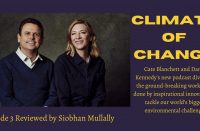In People of a Feather, filmmaker and ecologist Joel Health takes viewers on an Arctic adventure with time-lapse video footage, underwater photography, and raw scenes of Inuit life to show how environmental changes are impacting the people and wildlife of the Belcher Islands in Canada’s Hudson Bay. The film was recently nominated for the Best Feature Documentary award at the upcoming 2014 Canadian Screen Awards – Canada’s equivalent of the Academy Awards. The winner will be announced at the Screen Awards in Toronto on Sunday, March 9.
In People of a Feather, filmmaker and ecologist Joel Health takes viewers on an Arctic adventure with time-lapse video footage, underwater photography, and raw scenes of Inuit life to show how environmental changes are impacting the people and wildlife of the Belcher Islands in Canada’s Hudson Bay. The film was recently nominated for the Best Feature Documentary award at the upcoming 2014 Canadian Screen Awards – Canada’s equivalent of the Academy Awards. The winner will be announced at the Screen Awards in Toronto on Sunday, March 9.
The film focuses on the remote Inuit community of Sanikiluaq and explores their cultural connection with the eider duck, a species that has been facing large die-offs since the 1990s due to changing ocean currents and unpredictable sea ice conditions. Recreations of traditional Inuit life 100 years ago are juxtaposed with contemporary challenges as both eiders and community members struggle to cope with environmental changes driven by large upstream hydroelectric dam operations. Although it takes Health a relatively long time to convey his main argument, the message is clear: Climate change and the massive hydro dams that power eastern North America are threatening traditional Inuit ways of life, and creating large problems for Arctic sea ice ecosystems and global ocean currents.
Problems typically arise in the fall, when electricity demands increase and massive amounts of fresh water are released from dams into Hudson Bay, essentially reversing the seasons in the Bay. Since fresh water freezes before salt water, open areas are now freezing faster and more frequently, trapping eiders in closing ice and blocking them from accessing their feeding grounds. Although the film provides a clear and simple overview of the science behind these changes, it would have benefited from a macro-level narrative about declining Inuit culture and the historical political backdrop of the situation.
Those expecting a traditional documentary may be taken aback by Heath’s unconventional yet creative filmmaking style. Rather than showing talking-heads, Health gives viewers an up-close and raw look at the ecological and livelihood challenges being faced by people living in the community. Heath splits the film’s time between remarkable wildlife footage and authentic ethnographic content, the mix of which makes the film feel more experiential than intellectual.
Although Heath’s unique documentary approach limits the film’s commercial suitability, People of a Feather has performed well on small screens and has been well received by a diversity of viewers interested in learning about Inuit life in a changing and increasingly challenging Arctic environment. The film’s recent nomination has helped it attract a broader audience that extends beyond the typical environmentally conscious crowd.
People of a Feather has helped give the Inuit and environmentalists a strong enough voice to initiate a dialogue with the hydroelectric industry. Despite the industry’s reluctance to seriously consider their impacts on sea ice change, the film has drawn international attention to the cumulative impacts of hydro dams on Arctic marine ecosystems around the world.
The film concludes with heart-tugging scenes of starving eider ducks being frozen underneath the ice, challenging viewers to reflect on the environmental consequences of the choices we make everyday. Whether viewers will care that the comfort of warm homes comes at the expense of a small fuzzy bird – and the surrounding natural and human ecosystem – remains questionable.
Reviewer Information
Blair Carter is an ERS grad student at the University of Waterloo where she is researching the relationship between water and well-being in a small aboriginal community in Canada’s Northwest Territories.











